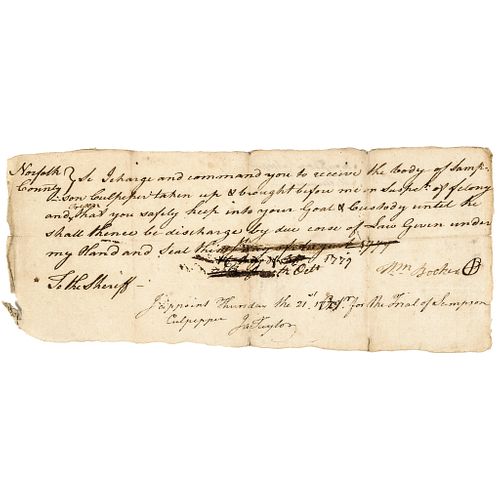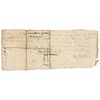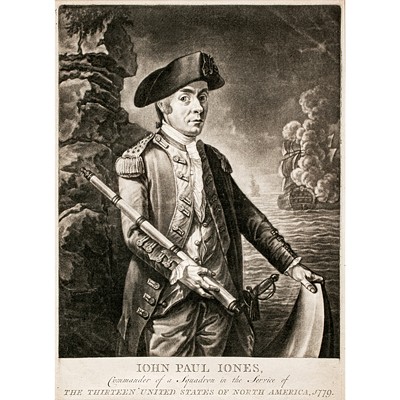1779 Norfolk Virginia Revolutionary War Warrant for a FELONY + TREASON Suspect
Lot 96
Categories
Estimate:
$1,200 - $1,800
Absentee vs Live bid
Two ways to bid:
- Leave a max absentee bid and the platform will bid on your behalf up to your maximum bid during the live auction.
- Bid live during the auction and your bids will be submitted real-time to the auctioneer.
Bid Increments
| Price | Bid Increment |
|---|---|
| $0 | $10 |
| $200 | $20 |
| $300 | $25 |
| $500 | $50 |
| $1,000 | $100 |
| $2,000 | $200 |
| $3,000 | $250 |
| $5,000 | $500 |
| $10,000 | $1,000 |
| $20,000 | $2,000 |
| $30,000 | $2,500 |
| $50,000 | $5,000 |
| $100,000 | $10,000 |
| $200,000 | $20,000 |
| $300,000 | $25,000 |
| $500,000 | $50,000 |
About Auction
By Early American History Auctions
Jan 23, 2021
Set Reminder
2021-01-23 12:00:00
2021-01-23 12:00:00
America/New_York
Bidsquare
Bidsquare : Early American History Auction of Autographs, Americana, Political & Maps
https://www.bidsquare.com/auctions/early-american-history-auctions/early-american-history-auction-of-autographs-americana-political-maps-6311
311 Lots of Rare, Historic Autographs, Americana, Civil War Era, George Washington, Abraham Lincoln, Slavery & Black History, Revolutionary War Era, Colonial America, Federal Period, War of 1812, Colonial Currency, Indian Peace Medals & more... Early American History Auctions auctions@earlyamerican.com
311 Lots of Rare, Historic Autographs, Americana, Civil War Era, George Washington, Abraham Lincoln, Slavery & Black History, Revolutionary War Era, Colonial America, Federal Period, War of 1812, Colonial Currency, Indian Peace Medals & more... Early American History Auctions auctions@earlyamerican.com
- Lot Description
American Revolution
1779 Norfolk County, Virginia "Suspect of Felony and TREASON" Revolutionary War Arrest Warrant
October 21, 1779-Dated Revolutionary War Period, Manuscript Document Signed, "Ja. Taylor", Court Arrest Warrant "To the Sheriff" for the arrest of Sampson Culpepper on "Suspect of Felony and Treason," with Trial Date after apprehension now set, Norfolk County (Virginia), Fine.
Handwritten Revolutionary War WARRANT from a Norfolk County Court for the Sheriff to arrest Sampson Culpeper as suspect in Felony and Treason, the Trial date set by magistrate James Taylor. James Taylor was a Delegate from Norfolk, Virginia to the Constitutional Conventions of Virginia, also an Alderman and Mayor serving 1766, '78, '82 and '90, then becoming a magistrate at Norfolk in 1779. At this time there was turmoil as on May 9, 1779 British forces raided Norfolk, Virginia led by Major General Edward Matthew and Commodore George Collier. They disperse the garrison at Fort Nelson and raid Norfolk. They captured large quantities of both war materiel and tobacco, while destroying numerous coastal vessels and two French merchantmen. Everything we could reasonably locate regarding Sampson Culpepper's biography is online. It appears he was ultimately vindicated of the charges against him.
This original Manuscript Court Document is in brown ink on watermarked laid period paper, measuring 3.5" x 8.5" having an elaborate large central Pro Patria or Maid of Dort Watermark, with the text "PROPATRIA" at right of a vignette of a Seated Woman with her staff, together with a British Lion within a fenced area. Expected folds, some edge wear and roughtness at left, with manuscript line corssed out text changes. Treason is a political crime, committed against a state or government to which the person charged with Treason owes a duty of allegiance. Based on this Document and research of other historical records, it is likely that Sampson Culpepper was actually a Revolutionary War Patriot and soldier with nothing of substance resulting from the charges brought against him. Regardless, a rare, and incredible Revolutionary War period collectible Document with the court ordering the Sheriff to apprehend Culpepper. Notation on the blank reverse reads: "Thursday 12 August" with Docket: "Sampson Culpeper". This warrant and trial set date Document reads, in full:
"Norfolk County - I charge and command you to receive the body of Sampson Culpeper (sic) taken up & brought before me on Suspect of felony and Treason that you safely keep (him) into your Goal (Jail) & Custody until he hence be discharged by due corse (sic) of Law Given under my Hand and Seal this (some text and dates crossed out and illegible: "day of August 1779," Changed to) Oct. 1779. - (Signed) Wm. Booker (with his manuscript seal)". Noted below: "To the Sheriff" - I appoint Thursday the 21st Oct.r for the Trial of Sampson Culpepper. -- (Signed) Ja. Taylor".
Norfolk County, Virginia had been a strong base of British Loyalist support throughout the American Revolution. On May 9, 1779 British forces raided Norfolk, Virginia led by Major General Edward Matthew and Commodore George Collier. They disperse the garrison at Fort Nelson and raid Norfolk.
They captured large quantities of both war materiel and tobacco, while destroying numerous coastal vessels and two French merchantmen ships. The expedition landed May 10th at Portsmouth, and took possession of the undefended town. Detachments then moved on to capture Suffolk, Gosport, and other small towns without opposition - except at Gosport where a garrison of 100 held out for awhile in Fort Nelson. Every nearby town was invaded as well as neighboring plantations. All were pillaged and burned.
Everything we could reasonably locate regarding Sampson Culpepper's Biography is as follows and it appears he was vindicated of the charges against him:
Sampson Culpepper was the son of Joseph Culpepper, and the grandson of Robert Culpepper of Norfolk Co, VA. He was probably born in Bertie County, NC about 1737. The area became Edgecombe County in 1741. Sampson was about eight years old when his father Joseph died unexpectedly in 1745. His mother, Martha Culpepper, was appointed his guardian, since he was under age 14. We know from his mother's will that he was the youngest son.
Sampson moved to Anson Co., NC with the rest of his family around 1753 or 1754. The Culpeppers appeared in deed records in Anson as early as July 1754. In Oct 1758, Sampson was granted 200 acres in Anson Co. on the S.W. side of Pee Dee River, joining the E. side of Gould's Fork of Brown Creek and both sides of the great fork of said Fork (NC Patent Book 16, p.260). Sampson was about aged 21 at the time, a young bachelor.
Sampson appears in a 1763 Tax List of Anson County, as do his brothers Joseph and John, and his cousins William and Robert. About 1764, Sampson married Eleanor Gilbert. The eldest child was born in 1765. In March 1767, Sampson Culpepper bought 62 acres from George Augustus Selwyn. The land was on Long Creek and the waters of Rocky River, and included Sampson's "own improvements," indicating he already lived there (Anson Deed Bk H1-129). In July 1776, Sampson sold the 200 acres he had acquired in 1758 to Patrick Boggan (Anson Deed Bk K, p.485).
Sampson Culpepper was probably a Patriot during the Revolutionary War, as indicated by one or more of the following Revolutionary War Pay Vouchers, for services rendered:
No. 847 - State of North Carolina, Auditors Office for the lower board of Salisbury District, 6th Sept 17_. This may certify that Sampson Culpepper exhibited his claim and was allowed Twenty-two Pounds, Five shillings and no Pence. /s/ John Ault, Stephen Miller.
No. 483 - State of North Carolina, Auditors Office for the Counties of Anson, Montgomery & Richmond. September 3rd 1782. This may certify that Sampson Culpepper exhibited his claim & was allowed Twenty-three Pounds Two Shillings no Pence. /s/ Stephen Mills, Thos. Chiles. Received the 23 d of April 1787 of John Richardson the above paid in full. /s/ Wm. (W) Culpepper. His mark.
No. 793. State of North Carolina, Auditors Office for the lower board of Salisbury District, 6th September 1782. This may certify that Sampson Culpepper exhibited his claim and was allowed Eight Shillings no Pence. /s/ John Auld, Thos Chiles.
The following two vouchers are found in the book by Weynette Parks Haun, "North Carolina Revolutionary Army Accounts, Secretary of State, Treasurer's & Comptroller's Papers, Vol. V, Vol. VI, Part IV."
No. 953. S. Culpepper, found in Vol. V, book 178, which is, "An accot. of Cloathing Currency and Specie Certificates sent to the Commissioners at New York by the Comptroller of Public Accounts of the State of North Carolina, May 1790. Note that vouchers of this description were for uniforms for soldiers in the Continental Line, the costs of which were reimbursed by the Federal Government in New York. So this is proof that a Sampson Culpepper served in the Continental line.
No. 1456. = S. Culpepper, found in Vol. VI, book 24 records a pay voucher. Note that one or more of the aforementioned five vouchers may apply to another Sampson Culpepper, who was the son of this Sampson's brother John, and who was also in this area at this time. It is not clear, however, that this younger Sampson was old enough to have served.
After the Revolutionary War, Sampson moved to Wilkes Co., GA., joining his brother Joseph who was already there. Sampson was there prior to Aug 1788, when he witnessed a deed of Elijah Clark (Wilkes Co. Deed Bk GG, p.94). He was listed as a Grand Juror in Wilkes Co. about 1789.
In Jul 1791, Sampson, now about 54 years old, was granted 200 acres in Washington Co. bounded on the northeast by John Culpepper (Register of Grants Bk. UUU, p. 596). Washington Co. was formed in 1784 from the Creek cession of November 1783.
Sampson and other Culpeppers were in Washington Co. at the time of the drawing for the 1805 Land Lottery. Sampson had two draws, both blank. In 1807 Laurens Co. was formed from Washington, and Sampson's land probably fell in Laurens County.
Sampson's wife, Eleanor entered the 1807 lottery, and she could not have done that unless she was a widow. Therefore, Sampson must have died after the 1805 but before the 1807 lottery.
- Shipping Info
-
Early American provides in-house worldwide shipping. Please contact us directly if you have questions about your specific shipping requirements.
-
- Buyer's Premium



 EUR
EUR CAD
CAD AUD
AUD GBP
GBP MXN
MXN HKD
HKD CNY
CNY MYR
MYR SEK
SEK SGD
SGD CHF
CHF THB
THB












